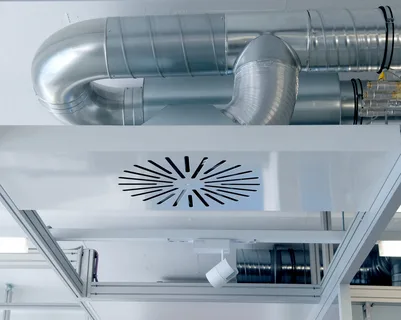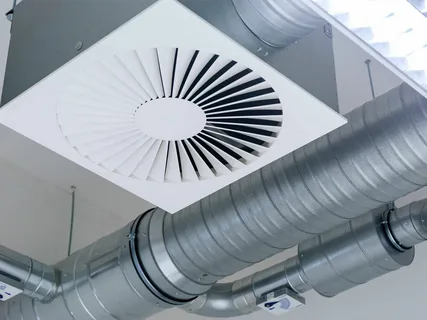Proper Air Ventilation is more than just a necessity for maintaining a comfortable living space – it is essential for your overall well-being. The air we breathe has a direct impact on our health, and ensuring that it is clean and fresh can make a significant difference in how we feel and function on a daily basis. Delve into the importance of air-ventilation for your health, the benefits of incorporating a fresh air-heater into your home, and how balanced-ventilation systems can optimize your indoor environment for optimal well-being.
The Importance of Air-Ventilation for Your Health
Proper air-ventilation is essential for maintaining good health and well-being. It plays a crucial role in ensuring that the air you breathe is clean and free from pollutants and allergens. By allowing fresh air to circulate throughout your home, you can prevent the buildup of harmful substances that could negatively impact your respiratory system.
Breathing clean air can improve respiratory function and contribute to an overall higher quality of life. It can help reduce the risk of respiratory issues such as asthma and allergies. Additionally, a well-ventilated space can inhibit the growth of mold and mildew, which are known triggers for respiratory problems.
Regular air-ventilation is also beneficial for eliminating odors and creating a more comfortable living environment. By ensuring that your home is well-ventilated, you can enjoy a breath of fresh air every day and promote better health for yourself and your loved ones.
 Benefits of a Fresh Air Heater in Your Home
Benefits of a Fresh Air Heater in Your Home
Introducing a fresh air heater into your home brings several significant benefits that enhance comfort, energy efficiency, and overall well-being. Here are the key advantages:
Improved Indoor Air Quality
Fresh air-heaters, also known as heat recovery ventilators (HRVs) or energy recovery ventilators (ERVs), continuously bring in fresh outdoor air while expelling stale indoor air. This process helps remove pollutants, allergens, and excess moisture from your home, thereby improving indoor air quality.
Enhanced Comfort and Temperature Control
Fresh air-heaters integrate seamlessly with your existing heating system, providing balanced ventilation without compromising indoor comfort. During the colder months, they preheat incoming fresh air using the warmth from outgoing stale air, ensuring that the air brought into your home is comfortably warm.
Energy Efficiency and Cost Savings
By recovering heat from outgoing air, fresh air-heaters improve energy efficiency in your home. They minimize heat loss during ventilation, allowing you to retain more of the energy used for heating. This efficiency not only reduces energy consumption but also lowers utility bills over time.
Moisture Control and Condensation Prevention
Proper ventilation is crucial for controlling indoor humidity levels and preventing moisture buildup, which can lead to mold growth and structural damage. Fresh air-heaters help regulate humidity by exchanging moisture between incoming and outgoing air streams.
Industrial-Ventilation Solutions for a Healthy Workspace
Industrial-ventilation solutions are paramount for ensuring a healthy and safe workspace within manufacturing and industrial environments. By effectively controlling and circulating air, these systems remove contaminants such as dust, fumes, and airborne particles that can pose health risks to workers. Implementing proper ventilation not only improves air quality but also regulates temperature and humidity levels, creating a more comfortable environment conducive to productivity.
Moreover, these solutions mitigate potential hazards like chemical exposures or combustion gases, enhancing overall workplace safety. Employing advanced technologies such as HEPA filters, exhaust fans, and air scrubbers, industrial-ventilation systems uphold regulatory standards and promote a healthier atmosphere, supporting the well-being and efficiency of employees.
Maximizing the Benefits of Air Ventilation Unit
Proper Air Ventilation Unit is crucial for maximizing numerous benefits across various environments, from residential homes to commercial spaces and industrial settings. By ensuring adequate air circulation, ventilation systems effectively reduce indoor pollutants such as volatile organic compounds (VOCs), allergens, and mold spores. This significantly improves indoor air quality, which is vital for respiratory health and overall well-being. Furthermore, maintaining optimal ventilation helps regulate temperature and humidity levels, creating a comfortable and pleasant environment for occupants.
In industrial contexts, effective ventilation not only removes airborne contaminants but also helps dissipate heat generated by machinery, thereby preventing overheating and ensuring equipment longevity. Proper ventilation systems can also control odors and reduce the risk of fire or explosion by managing potentially hazardous gases and vapors. By complying with regulatory standards and best practices, businesses can mitigate legal liabilities and safeguard the health and safety of employees.
In residential and commercial buildings, well-designed ventilation systems contribute to energy efficiency by facilitating the exchange of stale indoor air with fresh outdoor air. This reduces the need for excessive heating or cooling, leading to cost savings and environmental benefits.
Improving Indoor Air Quality with a Fresh Air-Heater
Improving indoor air quality with a fresh air-heater involves harnessing advanced technology to introduce and circulate clean, fresh outdoor air into indoor spaces. Unlike traditional heating systems that recirculate existing air, fresh air-heaters continuously bring in outside air, which is then filtered and distributed throughout the building. This process effectively reduces the concentration of indoor pollutants such as dust, allergens, volatile organic compounds (VOCs), and odors. By promoting better ventilation and air exchange, fresh air-heaters help maintain optimal humidity levels and prevent the buildup of stale air that can lead to respiratory issues and discomfort.
Furthermore, fresh air-heaters contribute to a healthier and more comfortable indoor environment by regulating temperature more efficiently. They can heat incoming air while also controlling humidity, ensuring a balanced and pleasant atmosphere year-round. This capability not only enhances occupant comfort but also supports productivity and well-being in residential, commercial, and industrial settings.
Achieving Well-Being through Balanced Ventilation System
Balanced ventilation system ensures a constant flow of fresh air while maintaining energy efficiency. It is crucial for achieving optimal comfort and promoting a healthier living environment. Here are some key points to consider:
- Proper ventilation helps regulate temperature and humidity levels in your home, ensuring a comfortable living space.
- It can reduce indoor air pollutants, such as dust and allergens, improving overall air quality.
- Well-maintained ventilation systems can enhance indoor air circulation, preventing stuffiness and promoting better health outcomes.
Investing in balanced-ventilation systems is an essential step towards creating a well-ventilated environment that contributes to your overall well-being. By understanding the benefits and importance of proper air circulation, you can enjoy a healthier and more comfortable living space.
The Science behind a Balanced-Ventilation System
A balanced-ventilation system operates on the fundamental principles of air exchange and circulation to maintain optimal indoor air quality while conserving energy. This system consists of two separate duct systems: one for bringing fresh outdoor air into the building (supply) and another for exhausting stale indoor air (exhaust). The key science behind a balanced-ventilation system lies in achieving equilibrium between these two air flows.
Firstly, the supply ducts deliver fresh outdoor air into living or working spaces. This air is typically filtered to remove pollutants and allergens before entering the building. By controlling the rate at which outdoor air is supplied, the system ensures a consistent flow of clean air, replenishing oxygen levels and diluting indoor contaminants. Simultaneously, exhaust ducts remove stale air from kitchens, bathrooms, and other areas prone to moisture and pollutants.
This exhaust process not only removes odors and excess humidity but also prevents the buildup of indoor pollutants such as carbon dioxide and volatile organic compounds (VOCs). The balance is crucial: the amount of air supplied must equal the amount exhausted, ensuring that air pressure within the building remains stable. This equilibrium prevents issues like backdrafting (where exhaust gases are drawn back into the building) and ensures efficient operation of heating and cooling systems.
Creating a Healthy Environment with Industrial Ventilation
Creating a healthy environment through industrial ventilation involves implementing sophisticated systems designed to manage air quality and safety within manufacturing and industrial facilities. These ventilation solutions are pivotal in controlling and removing airborne contaminants such as dust, fumes, gases, and particulates generated during industrial processes.
By effectively capturing and filtering these pollutants, industrial-ventilation systems significantly reduce the risk of respiratory problems and occupational illnesses among workers. Moreover, industrial-ventilation plays a critical role in regulating temperature and humidity levels within workspaces. This not only enhances employee comfort but also contributes to the efficient operation of machinery and equipment, preventing overheating and potential breakdowns.
Strategically designed ventilation systems also help mitigate the risk of fire and explosion by controlling the dispersion of flammable gases and vapors. They ensure compliance with safety regulations and standards, safeguarding both personnel and property from potential hazards.
Conclusion
Proper air ventilation is not just a luxury but a necessity for maintaining good health and well-being. Whether it’s in your home or workplace, ensuring a constant flow of fresh air can have a significant impact on your overall quality of life. From preventing respiratory issues to improving indoor air quality, the benefits of proper air-ventilation are undeniable. Whether you choose a fresh air-heater, balanced-ventilation system, or industrial-ventilation solutions, investing in the right ventilation system can go a long way in creating a healthier and more comfortable environment for you and your loved ones.
FAQs
What is air ventilation, and why is it important for well-being?
Air ventilation refers to the process of exchanging indoor air with outdoor air to improve air quality. It removes pollutants, odors, and moisture, ensuring a healthier indoor environment. Proper ventilation is crucial for reducing indoor allergens, preventing mold growth, and maintaining respiratory health.
How does proper air-ventilation benefit health?
Proper air-ventilation helps remove indoor pollutants such as volatile organic compounds (VOCs), allergens, and bacteria, which can trigger respiratory issues and allergies. It also regulates indoor humidity levels, preventing the buildup of mold and mildew that can exacerbate respiratory conditions like asthma.
What are the signs that a space lacks proper ventilation?
Signs of inadequate ventilation include stale or stuffy air, lingering odors, and condensation on windows, visible mold growth, and an increase in allergic reactions or respiratory symptoms among occupants. These indicators suggest that indoor air quality may be compromised and that improved ventilation is needed.
How can proper air-ventilation contribute to better sleep quality?
Good air-ventilation promotes better sleep by maintaining optimal temperature and humidity levels in bedrooms. It helps remove allergens and pollutants that can disrupt sleep and improves overall comfort by ensuring a fresh and breathable indoor environment.
Can proper air-ventilation help reduce energy costs?
Yes, proper air-ventilation can contribute to energy efficiency by reducing the need for excessive heating or cooling. Natural ventilation methods, such as cross-ventilation and strategically placed windows, can help regulate indoor temperatures more effectively, potentially lowering energy bills.
What are the benefits of workplace ventilation for employee productivity?
Adequate ventilation in workplaces improves employee productivity and well-being by enhancing indoor air quality. It reduces the risk of sick building syndrome, where poor air quality contributes to symptoms like headaches, fatigue, and irritability, thereby fostering a healthier and more comfortable work environment.
| Other Good Articles to Read |
| Niche Blogs Connect |
| Blogs 97 |
| Blog Stitution |
| Blogs Unplugged |
| Blogs Cotch Rouge |
| Blog Signatr |
| Blog Sintonias |
| Blog Zilla |
| Consumer Forums |
| Finance Forums |
| G Blogs |
| Too Blog |
| Related Business Listings |
| Contact Directory |
| Local Business Profiles |



